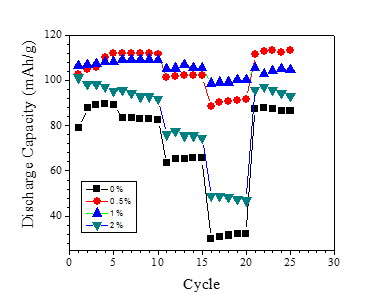The Incorporation of Graphene to LiCoO2 as a Cathode to Improve the Performance of LIBs
Student: Kenan Wang
Degree: M.S., May 2018
Major Professor: Dr. Simon S. Ang
Research Area(s):
Microelectronics
Photonics
Background/Relevance
- Electric cars has huge potential in the future, but current Lithium ion batteries have not enough capacity used in electric cars.
- Graphene has been widely used in several fields, and it shows great improvements to different applications.
Innovation
- Incorporating graphene into cathode materials to test the performance of cathode.
Approach
- Pristine cathode and cathode incorporated graphene were prepared first.
- Many “half cells” were assembled in the glove box.
- The electrochemical impedance spectroscopy measurements for “half cells” were achieved using a CHI660D Analyzer.
- Full cycles of charging and discharging of sample cells were finished using a BT2000 Battery Tester
Key Results
- Samples incorporated with 0.5 wt.% graphene sample has the largest discharge capacity compared with other samples.
- Samples incorporated with 1 wt.% graphene show the most stable discharge capacity compared with other samples.
- The incorporation of 2 wt.% graphene enhance the performance of cathode.

Conclusions
- The incorporation of graphene enhance the battery performance with a LiCoO2 cathode.
Future Work
- Further work could focus on adding higher weight percentages (>2 wt.%) of graphene powder into cathode materials to analyze the connection between different weight percentages of graphene powder added and the performance of lithium ion batteries.
